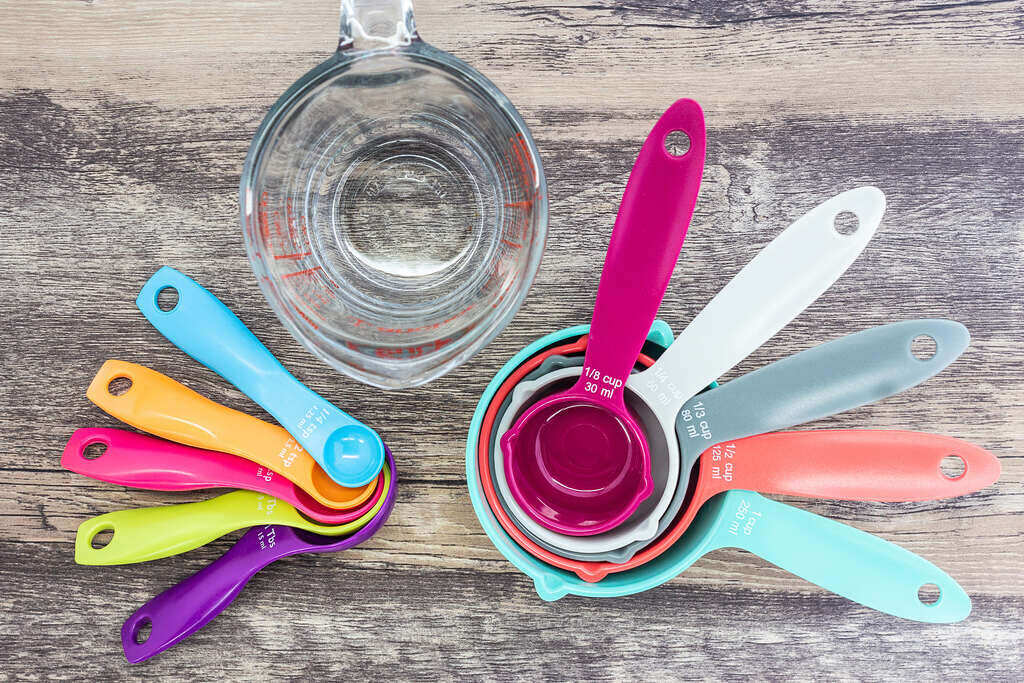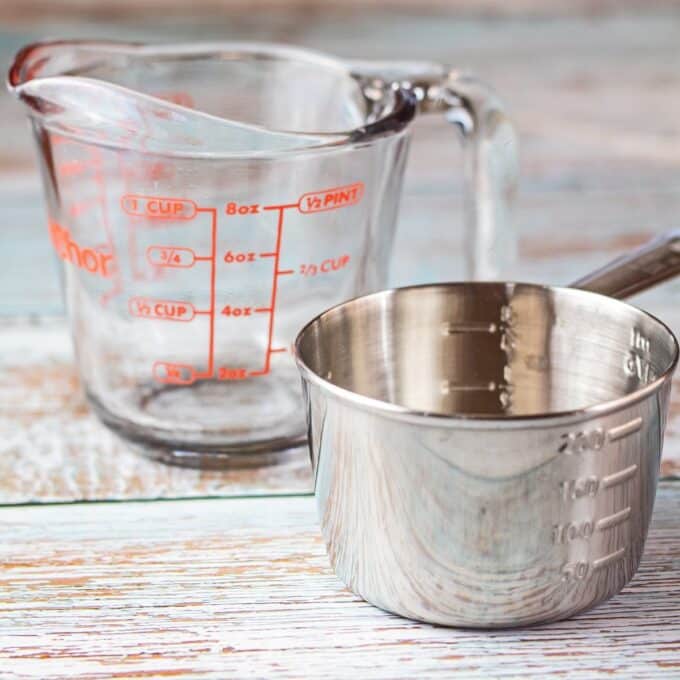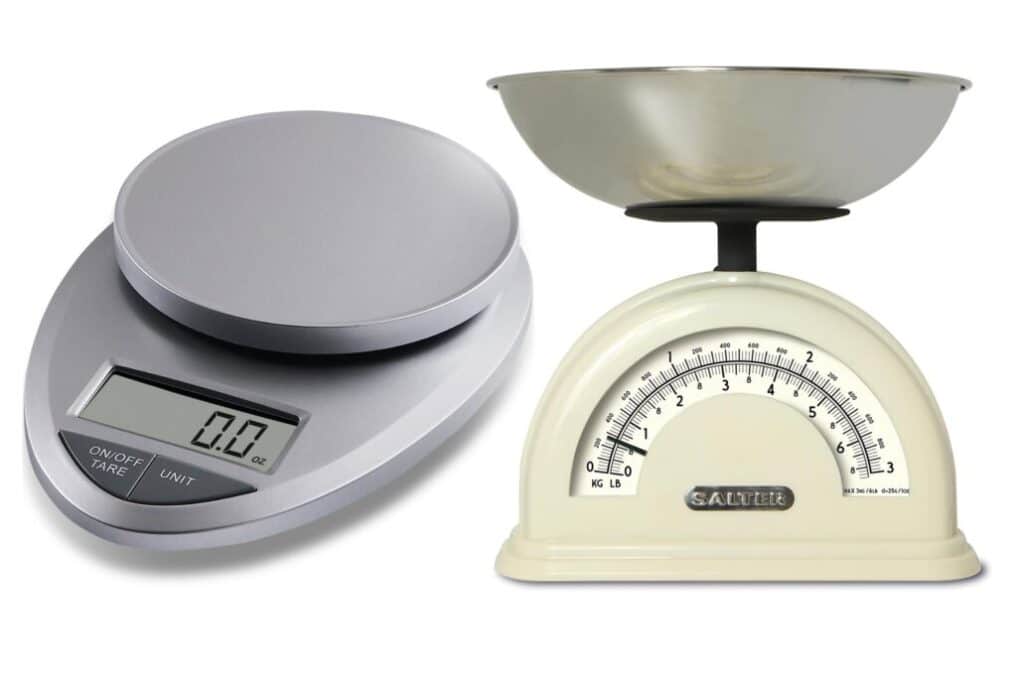How many ounces in a cup? This is a common question asked by many home cooks and bakers. Understanding the measurement of ingredients is crucial to achieving successful cooking and baking outcomes.
While cups and ounces are both used in recipes, it’s important to know the conversion between the two to ensure accurate measurements.
In cooking and baking, precise measurements are crucial to achieving the desired results. Two common units of measurement used in recipes are ounces and cups. Ounces are a unit of weight, while cups are a unit of volume.
Understanding the relationship between these two units is essential to measuring ingredients accurately. In this article, we will explore the conversion factor between ounces and cups, as well as provide tips for accurate measuring to help you become a better cook or baker.

Set of measuring spoons, measuring glass and a measuring cup use in measuring
CHECK THESE OUT:
- How to Make Nigerian Buns: Easy Guide
- Chicken Legs Recipe Drumstick: How to make them
- How to make Puff Puff
Understanding Ounces and Cups
Ounces and cups are two different units of measurement used in cooking and baking.
An ounce is a unit of weight commonly used in the United States and the UK. In cooking and baking, ounces are often used to measure dry ingredients such as flour, sugar, and spices.
Fluid ounces, on the other hand, are used to measure liquid ingredients such as water, milk, or oil.
A cup, on the other hand, is a unit of volume used in cooking and baking to measuring both dry and liquid ingredients. One cup is equivalent to 8 fluid ounces or 16 tablespoons.
It’s important to note that when measuring ingredients, it’s crucial to use the correct unit of measurement as directed in the recipe to achieve the desired results. A slight variation in the number of ingredients can significantly affect the outcome of the dish.
Converting Ounces to Cups
When it comes to cooking and baking, it’s important to know how to convert measurements accurately. One common conversion is ounces to cups. Here’s how to do it:
Converting Fluid Ounces to Cups
Determine the number of fluid ounces you need to convert.
Divide the number of fluid ounces by 8. This will give you the equivalent number of cups.
For example, if you have 16 fluid ounces, divide 16 by 8, which equals 2 cups.
How Many Fluid Ounces in a Cup
How many fluid ounces are there in a cup? There are exactly 8 fluid ounces (fl oz) in 1 cup.
So, a cup of water, coffee, or milk will always be equal to 8 ounces. Liquids are always comparable in weight and volume due to their similar form. Using fluid ounces is the most accurate way to measure them.
The conversion chart below will teach you how to convert ounces to cups using a simple formula:
Remember that 1 ounce is equivalent to 0.125 cups. So simply multiply the number of ounces by 0.125 cups for this conversion.
Here are some examples:
8 fl oz x 0.125 cup = 1 cups
16 fl oz x 0.125 = 2 cups
24 fl oz x 0.125 = 3 cups
32 fl oz x 0.125 cups = 4 cups

Converting Dry Ounces to Cup
When it comes to cooking and baking, it’s important to know how to convert measurements accurately. One common conversion is dry ounces to cups. Here’s how to do it:
Determine the number of dry ounces you need to convert.
Look up the density of the ingredient you are measuring. This will give you the conversion factor. For example, the conversion factor for all-purpose flour is 4.25.
Multiply the number of dry ounces by the conversion factor. This will give you the equivalent number of cups.
For example, if you have 8 ounces of all-purpose flour, multiply 8 by 4.25, which equals 34. Therefore, 8 ounces of all-purpose flour is equivalent to 3.4 cups.
It’s important to note that different ingredients have different conversion factors due to variations in density. Therefore, looking up the specific conversion factor for each ingredient you are measuring is important.
Read: How to Cook Ogbono Soup
How Many Dry Ounces in a Cup
Converting dry ounces to cups isn’t as straightforward as one might wish. As mentioned, most recipes prefer to measure dry ingredients by weight as they tend to differ in volume. Some occupy more space, while some are less, considering shape, size, and form factors.
You might think 1 cup of any dry ingredient would yield the same weight, but weight values will vary due to compressibility. Essentially, if a dry ingredient can be easily and firmly pressed into a container (like flour, sugar, and other baking powders), you can get a better estimate of its weight.
However, with dry goods like chocolate chips or blueberries, the ounce equivalent of a cup may fluctuate depending on the shape and size of the ingredient. These aren’t easily levelled with a scraper, so it’s much better to fill your cup to the brim when measuring such ingredients.
See: How to cook catfish pepper soup
Converting Cups to Ounces
Converting cups to ounces is a common kitchen measurement conversion. Whether you’re following a recipe or just need to convert measurements for a specific ingredient, knowing how to convert cups to ounces will help you achieve accurate results in your cooking and baking.
There are two types of ounces that are commonly used in recipes: fluid ounces and dry ounces. Fluid ounces are used for measuring liquids, while dry ounces are used for measuring solids.
To convert cups to ounces, you must know whether you are working with fluid or dry ounces. Once you have determined this, you can use the appropriate conversion factor to convert from cups to ounces.
Read: How to cook Egusi soup in easy-to-follow recipes
Measuring Tips
Measuring ingredients accurately is crucial for achieving the desired results in your cooking and baking. Here are some tips to help you measure ingredients correctly:
Use the right measuring tools
Different ingredients require different measuring tools. Liquid ingredients should be measured in liquid measuring cups, while dry ingredients should be measured in dry measuring cups. For small amounts, use measuring spoons.
Read: How to Make Nigerian Tofu Wara Soya in 16 Easy Steps
Level off dry Ingredients
When measuring dry ingredients, use a straight edge, such as a knife, to level off the top of the measuring cup or spoon. This ensures that you are using the exact amount of the ingredient called for in the recipe.
Don’t Pack Ingredients
When measuring ingredients such as flour or brown sugar, do not pack them down in the measuring cup. This can result in too much of the ingredient, which can affect the texture and flavour of your recipe.
See: 5 Common Nigerian Breakfast Ideas
Use weight measurements
In some recipes, weight measurements are more accurate than volume measurements. Using a kitchen scale to measure ingredients by weight can help you achieve more precise results in your cooking and baking.
Read the recipe carefully
Make sure to read the recipe carefully and follow the instructions for measuring ingredients. Some recipes may call for ingredients to be measured by weight or by volume or may require specific measuring tools.
By following these tips, you can ensure that you are measuring ingredients accurately and achieving the best results in your cooking and baking.
SEE ALSO:

Measuring Tools
Different types of measuring tools are commonly used in the kitchen. Here are some of the most common ones:
Measuring cups
Measuring cups are used to measure both liquid and dry ingredients. Liquid measuring cups are typically made of glass or plastic and have a spout for pouring. Dry measuring cups are usually made of metal or plastic and have flat edges for levelling off dry ingredients.
Measuring spoon
Measuring spoons are used to measure small amounts of ingredients such as spices or extracts. They usually come in sets that include 1/4 teaspoon, 1/2 teaspoon, 1 teaspoon, and 1 tablespoon.
See: Tastiest Nigerian Street Foods
Kitchen scale
A kitchen scale is used to measure ingredients by weight. This is especially useful for recipes that require precise measurements or for ingredients that are difficult to measure accurately by volumes, such as flour or sugar.
Measuring pitchers
Measuring pitchers are similar to liquid measuring cups, but they have a handle and are designed for measuring larger amounts of liquid ingredients.
Read: Tastiest Nigerian Foods to Try Out
Graduated cylinders
Graduated cylinders are tall, narrow cylinders that are used to measure liquids. They are especially useful for measuring small amounts of liquid ingredients with high precision.
By having the right measuring tools in your kitchen, you can ensure that you are measuring ingredients accurately and achieving the best results in your cooking and baking.
READ ALSO:
- How to Make Fufu (Foofoo) from Scratch
- Vegetable Soup Recipes: How To Cook the Nigerian Efo Riro
- How to cook fried rice one step at a time
How Many Ounces in a Cup of Butter
If you’re wondering how many ounces are in a cup of butter, the answer is 8 ounces. One cup of butter contains 16 tablespoons, and each tablespoon weighs 0.5 ounces. It’s important to note that the weight of butter can vary depending on its density, so measuring by weight is often more accurate than measuring by volume.
When using a recipe that calls for butter in cups, it’s helpful to know the conversion to ounces to ensure you’re using the correct amount. This is especially important in baking, where precise measurements are crucial for the recipe’s success. So, whether you’re making cookies, cakes, or any other baked goods, knowing how many ounces are in a cup of butter will help you achieve the perfect texture and flavor.
Related: How Many Teaspoons in a Cup
How Many Ounces in a Cup of Water
If you’re looking to accurately measure your water intake or follow a recipe that requires a specific amount of water, it’s important to know how many ounces are in a cup of water. In the United States, one cup of water is equivalent to 8 fluid ounces, which is a standard measurement used in cooking, baking, and for staying hydrated.
Understanding this measurement is crucial for maintaining a healthy level of hydration, as it’s recommended that adults consume at least 8 cups of water per day, or 64 ounces. By knowing how many ounces are in a cup of water, you can easily keep track of your daily water intake and ensure that you’re meeting your hydration goals.
So, the next time you’re preparing a recipe or trying to stay hydrated, remember that one cup of water equals 8 ounces. With this knowledge, you’ll be able to accurately measure your water intake and create delicious recipes with perfect consistency.
Related: How Many Ounces in a Pint
How Many Fluid Ounces are in a Cup
If you’ve ever followed a recipe, you know that accurate measurement is key to creating delicious meals and treats. One common question that arises when measuring ingredients is “how many fluid ounces are in a cup?” The answer is 8 fluid ounces. This means that if you need to measure out one cup of liquid, you will need 8 fluid ounces. It’s important to note that when measuring dry ingredients, such as flour or sugar, the measurement in ounces is by weight rather than volume. Therefore, 1 cup of flour is equivalent to 4.5 ounces, while 1 cup of granulated sugar is equivalent to 7.1 ounces. By knowing these conversions, you can ensure that your recipes turn out perfectly every time.
Related: How many Tablespoons in a Cup (convert tbsp to cup)
How Many Ounces in a Cup of Coffee
Keep in mind that serving sizes can vary depending on where you’re getting your coffee. Some coffee shops may serve smaller or larger cups, and some people may prefer a larger or smaller serving size at home. Additionally, the type of coffee you’re making can also impact the serving size. For example, espresso shots are typically around 1 ounce, while a latte or cappuccino may be closer to 8-12 ounces. It’s important to keep these factors in mind when measuring out your coffee, so you can ensure the perfect brew every time.
Related: How Many Pints are in a Gallon? (Gallon to Pint Conversion)
How Many Ounces are in a Cup of Cheese
Generally, a cup of shredded cheese weighs about 4 ounces, while a cup of crumbled or diced cheese weighs about 3 ounces. However, it’s always best to weigh or measure cheese for accuracy, as different types can vary in density and moisture content.
For example, a cup of grated Parmesan cheese may weigh around 3 ounces, while a cup of feta cheese crumbles may weigh only 2 ounces. It’s important to keep these differences in mind when following a recipe or preparing a dish.
In conclusion, understanding the conversion between ounces and cups is essential for cooking and baking. Knowing the precise measurement of ingredients can make all the difference in the outcome of a recipe.
By following the conversion methods outlined in this article, you can confidently measure ingredients and create delicious meals and treats.
Remember to use measuring cups and spoons for accuracy and double-check your measurements. With these tips, you will be well on your way to becoming a pro at measuring ingredients.
Related: Oven Temperature Conversion C to F
